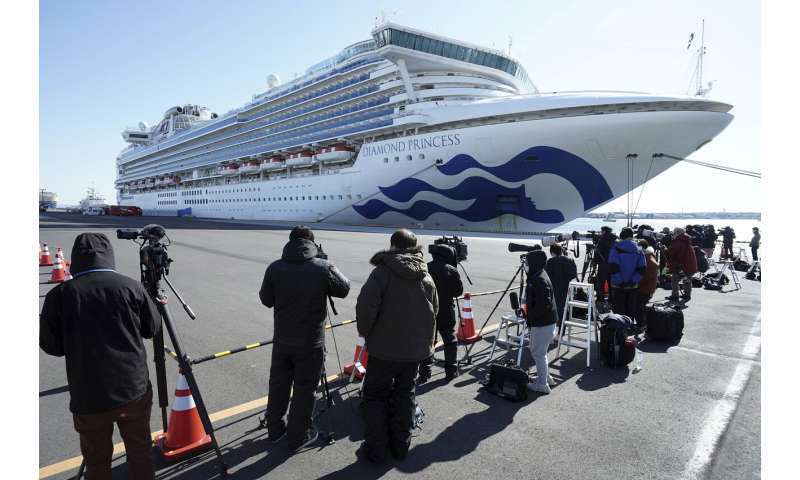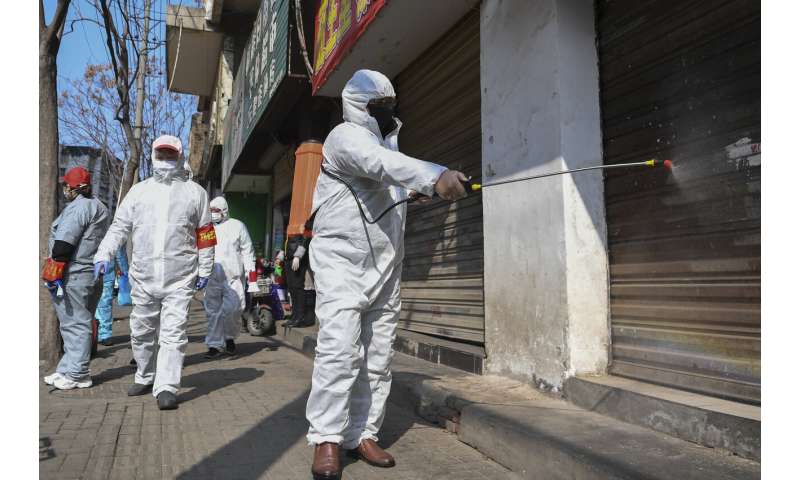
China reported a rise in new virus cases on Monday, possibly denting optimism that its disease control measures like isolating major cities might be working, while Japan reported dozens of new cases aboard a quarantined cruise ship.
The mainland death toll rose by 97 to 908, and 3,062 new cases were reported on the mainland over the 24 hours through midnight Sunday. That was up 15% from Saturday and broke a string of daily declines. A government spokesman had said Sunday those declines showed containment measures were working.
Japanese health officials said about 60 more cases found aboard the Diamond Princess, in addition to 70 cases found earlier among 3,711 passengers and crew. Health ministry officials were double-checking the results and could not immediately release the exact figure.
Japan’s Health Minister Katsunobu Kato said the government was considering testing everyone aboard, which would require them to remain on the ship until results are available. Health authorities also are scrambling to deliver medicine requested by more than 600 passengers.
“We are doing the utmost to keep everyone in good health,” Kato said.
The fatality toll from the new virus has passed the 774 people believed to have died in the 2002-03 epidemic of severe acute respiratory syndrome, another viral outbreak that originated in China. The total of 40,171 cases on the mainland of the new virus vastly exceeds the 8,098 sickened by SARS.

More than 360 cases have been confirmed outside mainland China, including two deaths in Hong Kong and the Philippines.
China has built two hospitals and sent thousands of extra doctors, nurses and other health care workers to Wuhan, the city of 11 million people in central Hubei province that is the epicenter of the outbreak. Most access to Wuhan was suspended Jan. 23 and restrictions were expanded since then to cities with a total of 60 million people.
Businesses are gradually reopening following the Lunar New Year holiday, which was extended to discourage travel in an attempt to contain the virus, but they face heavy losses.
With temperatures rising and snow melting, the capital Beijing began coming back to life, although with strict epidemic-control measures still in place. At the popular Sanyuanli wet market, face-masked customers mixed with delivery men collecting orders of meat, fruit and vegetables for city dwellers preferring to prepare meals at home rather than venture out to restaurants or take delivery of pre-cooked food.
Apartment blocks and gated communities have blocked direct delivery, requiring bags of goods be left with guards or in lockers set up at entrances by the major delivery firms.
Market stalls remained well-stocked with fresh pork, mutton, seafood and vegetables while there appeared to be no shortage of paper towels, toilet paper or cleaning supplies. While traffic had increased from last week, there were still far fewer cars on the road and people on the subways.

“The number of customers here is down a lot, maybe by more than half,” said Liu Ying, who sells walnuts, cashews and other local and imported specialties at the Xinyuan market. “But you can see a lot of people calling in orders so we’re slowly getting busy again.”
Asian stock markets slid Monday following warnings that investor optimism the disease and its economic impact were being brought under control might be premature.
China’s central bank announced a 300 billion yuan ($43 billion) fund to make low-interest loans to producers of medicine and medical supplies or other companies involved in fighting the virus.
Over the weekend, the government promised tax cuts and subsidies to farmers, supermarkets, producers of medical supplies and companies that contribute to anti-disease work.
China’s leaders are trying to keep food flowing to crowded cities despite the anti-disease controls and to quell fears of possible shortages and price spikes following panic buying after most access to Wuhan and nearby cities was cut off.
Consumer inflation spiked to an eight-year high of 5.4% over a year earlier in January, driven by a 4.4% rise in food costs, the government reported Monday. Food prices rose 1.4% from the previous month.

“It appears that supply disruptions and hoarding due to the coronavirus outbreak helped to keep food prices elevated during the week after Chinese New Year, when they would normally drop back,” said Julian Evans-Pritchard of Capital Economics in a report.
Meanwhile, the mother of a physician who died last week in Wuhan said in a video released Sunday she wants an explanation from authorities who reprimanded him for warning about the virus in December.
The death of Li Wenliang, 34, prompted an outpouring of public anger. Some postings left on his microblog account said officials should face consequences for mistreating Li.
“We won’t give up if they don’t give us an explanation,” said Lu Shuyun in the video distributed by Pear Video, an online broadcast platform.
Source: Read Full Article
